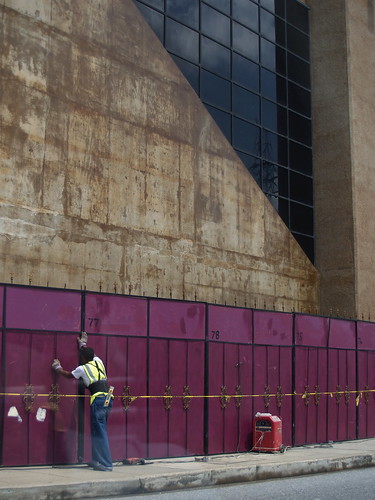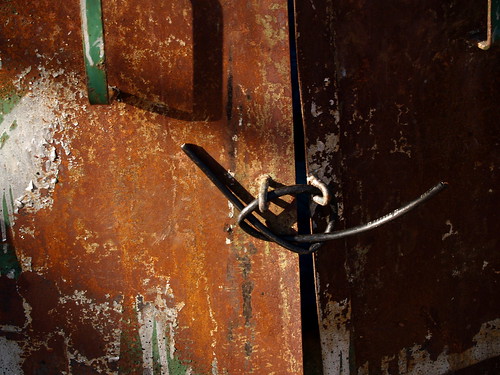
My focus on constructed boundaries has however, shifted after Carnival more towards locks. Locks have been a significant part of the culture shock that I’ve observed my fellow participants in the program going through. That’s not to say that I’m immune to this particular jarred familiarity. Rather, I went through similar steps of struggle, observation and presentation of the difference when I was living in South Africa. Here in Trinidad, I have observed just as many barred windows, and just as many locks, on shorter and less imposing fences surrounding houses. There is less barbed wire, and fewer visible security company stickers plastered onto windows of apartment complexes than in South Africa, but the same feeling is still present here in Trinidad; the feeling that all these “safety” measures are somehow necessary. If there wasn’t a lot of crime, either in theft and robbery, or some sort of attack, why would so many people in our residential neighborhood collectively or individually choose to have at least three or four locks separating “them” from “me” and the “dangerous outside” from the “safe inside?”
What I’ve then been photographically focusing on are the tangible “things” which lend a (false) feeling of security. In this, I’ve been focusing on doors, locks, gates and walls. However, I’ve also been attempting to expose the irony that this simple objects pose, in the creation and maintenance of “safety.” Do three locks on your door really make you safer, or is their presence alone making you more susceptible to irrational fears of the dangers that require those three locks to keep you safe? Does the bold black imprint of “SECRUTIY” on a booth make you feel better, knowing that someone is “always” watching? Or is that illusion broken when you come to see that the security booth’s windows are papered over, and the security guard only gets up from in front of his television program to pee in the corner of the compound, by the trash cans? What too, of gate locks, I ask? When one can download a guide of how to pick locks, and use any number of slim simple tools to open your padlock, or simply jump the gate, are those locks useful?
What I wonder, when I look and see so many “security measures” is how often these objects actually serve as protection, or if rather, they serve as indicators of homes with enough worth protecting. I also wonder at how those same potential indicators of wealth may serve to make someone feel worthy of protection, and somehow more safe and sheltered from the outside world.
In supposed “third world nations” like South Africa and Trinidad, I have also noticed the propensity of citizens and visitors alike, talking of the crime in the area to serve as a warning, or to show a particular suave or worldly understanding of criminal minds and how to avoid being a victim. However, regardless of how one may act, or what security is in place, one can never choose not to be a victim.
This leads me back to constructed boundaries. Locks, barred windows, and security systems do create visible and invisible boundaries between passers-bys and inhabitants. There is also a class component to such “security measures.” Who can afford a complex security system, and who must rely on personal vigilance to create security?
And, most interesting to me, in traveling from first to third to first to third, which nations, areas of those nations, and people within those nations feel the need for which types of security. The suburban neighborhood that my mother lives in relies on decorative walls and fences with unlocked latches, but keypad locked garages and homes with motion-sensor security systems, while my father, in a rural area of the same state, never locks his front door. In South Africa, where I felt I’ve been most actively taught to “feel” constant and imminent danger, vicious barking dogs lurk behind tall walls adorned with barbed wire, and houses sit behind locked gates, locked doors, and permanently barred windows. In Trinidad, I’m coming to terms with the seven keys it takes to access my space, and the growing awareness of similar security measures every where that I go.
Attitudes around locks and other boundaries I find, are rarely questioned. The importance of locking the outside gate is tantamount, and the importance of locking both the door and iron gate in front of my door is stressed, and further reinforced by the insecurity that other students feel when the door is open. And despite this seeming disavowal of locks and all other security measures, I do mind the norm. I lock both locks into my apartment, and keep the gates and doors of any of my spaces locked. After all, I don’t want to compromise the supposed safety of the complex that I live in, and the community that I’m therefore partially responsible for protecting through the three measly locks and obviously scale-able gates.
I also think it is clear, in my photo stream, that I’m attracted to and interested in photographing the color and contrast and ideological realities of locks. Due to their constant outdoor presence, many of the locks I find most compelling are covered in rust, accompanied by a bold color, strongly lit, or even missing, perhaps due to a previous break-in. Following my preoccupation with seeing the constructed boundaries of Carnival, I am interested in further exploring similarities perhaps, between locks as security and boundaries, and my camera as a boundary, and as security.
In my mind, even the lens of a camera can be construed as a boundary. It is a distinct separation of subject matter and photographer, and I am increasingly aware of this feeling as I continue to live and travel Trinidad and Tobago, and talk to my fellow photography students. One has remarked that it is often easier to “see” uncomfortable events and realities through their camera. While I have never consciously felt this way, I am now more aware of the potential truth of this statement in my own work. Is it sometimes easier for me, at an event, to simply get caught up within the colors and details and light?
As my awareness has grown to this potential boundary creation, I’ve tried to focus on the small events and details that are recognizable and human to any event. Within the glitzy and glittering fantastic scene of Carnival, I focused on a smile, or a sleeping child to bring home the shared humanity, even in a situation that I found new and strange. Rather than focusing only or purely on difference, I am instead trying to also see the little, often overlooked similarities.
Not all of these photos are successful. For example, the photograph of a child interacting with a Blue Devil around his age was underdeveloped and nearly unrecognizable, but I find it important for my own self-understanding and preservation and attempts of non-exploitative photography, to continue to try to capture these smaller, common human moments, even in the midst of an unfamiliar cultural happening. This makes me feel, at least, that my role is not entirely tourist-focused, nor entirely focused as an anthropologically focused student photographer. I’m also not committing to photojournalism in this, as many of these little moments are my favorite images, and not specific to any particular event, culture, or people.
It is this mental focus on commonality that led me to locks, and so the mental circle repeats itself as I continue to look to those connecting pieces and moments of every day interactions and life.

1 comments:
Your most interesting post to date. Very compelling questions and a nice flow between your questions and your images. Glad to see you pursuing this interest in your work.
Post a Comment